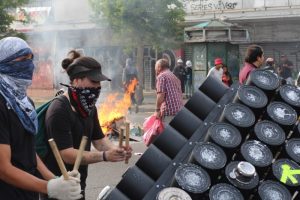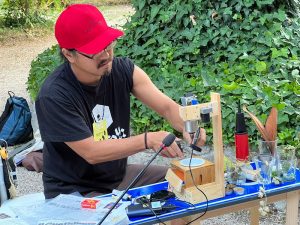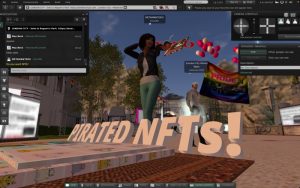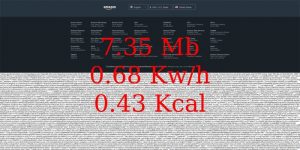A few months ago, i started covering in details the projects developed at the Interactivos? workshop which took place at Medialab Prado in Madrid in June (btw they have a Visualizar workshop going on this week, with a Communication Applied Data Visualization Seminary on November 23 you might want to check out if you’re in the neighbourhood). Well, i had kept another project in my closet for you.
Based on an augmented reality system, AR_Magic System allows users to exchange head with their neighbours. You stand in front of the computer screen, next to one or more persons and after a few seconds, your head appears on the shoulder of someone else and you get a new face yourself. I swapped head with Edgar Gonzalez while i was there and as i didn’t like the look of myself with a beard, i’d rather show you a video of other experiments:
Video of AR_Magic System
Clara Boj and Diego Diaz work together since 2000. They have developed and exhibited their artistic and research projects all over the world. They have been artists in residence at the Mixed Reality Lab, National University of Singapore and did some research at the Interface Culture Lab at Linz University.
I’ve been following the work of Clara and Diego for a couple of years and because i was curious about their other projects, i decided to run a longer feature on their work.
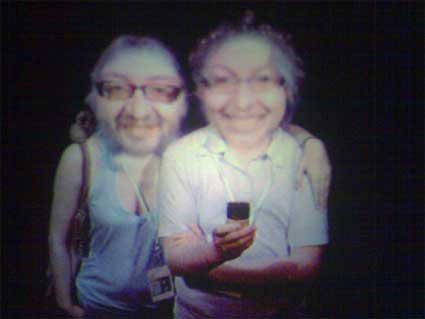 You started working on Free Network Visible Network in 2004. The main objective of the project was to “ask for the free access to the net and at the same time to make actions in the urban landscape as a way to create new meanings in the public domain.” When you look back at your ideas at the time, how do you feel? In particular about the free access issue(s)? What were the biggest challenges you encountered and were not expecting while working on the project?
You started working on Free Network Visible Network in 2004. The main objective of the project was to “ask for the free access to the net and at the same time to make actions in the urban landscape as a way to create new meanings in the public domain.” When you look back at your ideas at the time, how do you feel? In particular about the free access issue(s)? What were the biggest challenges you encountered and were not expecting while working on the project?
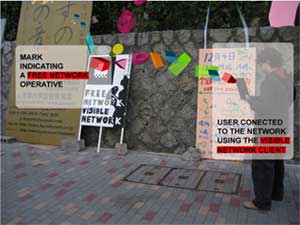 At that time several situations happened in Spain that brought us to start the Free Network Visible Network project. Some city councils started to offer free wifi acces all over their territory and there were plans to extend this network to other places. But the Telecommunications Market Commision (CMT) denounced this situation as a kind of illegal competence for the phone companies. Even when in some cases those networks were only offering access to the services of a local Intranet, not to the Internet. All this kind of projects supported by the small cities administrations were brought to a stop, and only some voluntary groups continued creating wifi networks all over the Spanish territory. The same situation was happening in other places in Europe and USA.
At that time several situations happened in Spain that brought us to start the Free Network Visible Network project. Some city councils started to offer free wifi acces all over their territory and there were plans to extend this network to other places. But the Telecommunications Market Commision (CMT) denounced this situation as a kind of illegal competence for the phone companies. Even when in some cases those networks were only offering access to the services of a local Intranet, not to the Internet. All this kind of projects supported by the small cities administrations were brought to a stop, and only some voluntary groups continued creating wifi networks all over the Spanish territory. The same situation was happening in other places in Europe and USA.
We were really worried about the privatization of digital space, due the control that some economic powers make over one of the more basic rights of citizens, the free use of the public space. So mainly we started the Free Network Visible Network project to collaborate with those groups of free wifi networks users and somehow to spread the idea of public space as something more than streets and parks.
Now, once the project is technically finished and has been installed in several places we still think that actions need to be taken to somehow make use of the digital public space with freedom. The situation with the big communication companies and legal practices it hasn’t changed much. Even is much more restrictive than before and in some places of Europe people have been fined for using their neighbours’ open wifi network.
One of the biggest challenges for us, apart from the technical difficulties, it has been the relations with institutions when we were showing the project at museums or official art spaces. It is not always easy to convince people from institutions to create a open wifi network and keep it running after the exhibition is finished. The notion of private property is very strong even for something as invisible as waves.
 Free Network Visible Network in Kyoto
Free Network Visible Network in Kyoto
What did the project teach you about the concept of public space?
Basically, this project not only represents the public space but it also allows people to experience it, in a hybrid dimension, as a combination of physical places and digital communication spaces. At present time we cannot talk anymore about public space without including all this non physical places that emerge when people talk, exchange information or play through digital networks. The combination of those territories, physical and digital, creates a new public sphere much more dynamic and changeable, rich in relationships and meanings. Free
Network Visible Network is a very useful tool to help understand those relations, and what is our situation, as users-citizens in this new domain.
You have used augmented reality technology in several of your projects, one of them is BE CAREFUL, FRAGILE. How was it like to present a high-tech art work in ARCO06, a “traditional” contemporary art fair? What did you try to convey with that particular artwork? How did the audience react to it?
This project had a great success among the ARCO visitors. At some point we were even asked to shut it down for a little bit because so many people were playing with it that they were collapsing the area.
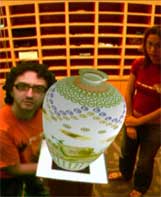
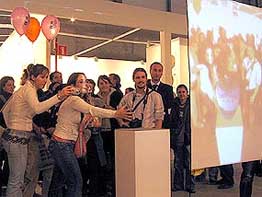
It was our first time exhibiting at ARCO and we were really concerned about traditional art market and digital media collectionism. It is a very old issue and we ourselves were very interested about how the traditional art market system should be applied to interactive installations. Questions like producing pieces in series, technical needs and maintenance, etc were some of the questions we were discussing with the gallery owner and it was clear that digital media have specifications that need to be carefully addressed when selling a piece to a private or institutional collector. For us it doesn’t make much sense to create a limited number series of a digital artwork when most of the time it can be contained in a cd and easily installed in any computer, even more when we are usually working with free software and our projects are registered under creative commons license. The
question was how to preserve the value of the uniqueness that traditional art market appreciate if anybody can download our source code from the web and make it themselves? It is traditional art market ready for this kind of situations?
So we did an interactive installation were a digital 3D modeled traditional vase was projected as it really was over a real pedestal. When visitors tried to touch it the vase fell down to the floor in a realistic way and finally was broken making a big noise. People were
very surprised when two pre-recorded persons (that were us) entered the scene bringing a new vase exactly identical and placed again over the real pedestal. This loop was repeated again and again each time people broke the vase. Somehow our piece exhibited at ARCO was a digital object and it could be infinitely reproduced.
It was really appreciated by the general audience and also by professionals and gallery owners. The audience was continuously playing with it, making the vase fall down again and again.
During the Interactivos? workshop in Madrid, you developed the very fun AR magic system. Can you explain us what made the work “magical’?
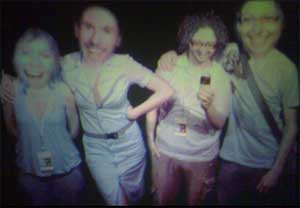 The magical aspect of this project is that it uses a very intuitive interaction for playing with the identity of the users. People just need to look at themselves in the video projection, that it acts like a mirror, and they will see their face interchanged with another person.
The magical aspect of this project is that it uses a very intuitive interaction for playing with the identity of the users. People just need to look at themselves in the video projection, that it acts like a mirror, and they will see their face interchanged with another person.
It is really amazing how people react when they look at themselves and see another face that is smiling or talking and they can not control the expression. It is as if somebody had supplanted your identity. For us it was a real surprise how people enjoyed this very simple idea and they played during long time and called their friends for see how it feels to be the other. During the time it was exhibited at MediaLab in Madrid and later at Sonar Festival in Barcelona, almost everybody who played with the piece took a picture of their transformed face. We found dozens of those pictures at flicker, which for us is a sign of how people enjoyed the experience.
One of the most magical aspects of this piece it how it plays with technological simplicity but with a really complex universe of meanings about identity.
Do you plan to develop that project any further?
Actually the project as it was developed during Interactivos? it is just a small part of the whole idea due the very limited time of the workshop and the difficulties we found with some technical aspects.
We would like to thanks Zachary Lieberman, Martín Nadal, Damien Stewart, Javier Lloret, Blanca Rego, Julio Lucio y Jordi Puig for their help programing the software which is written in C++ using the openFrameworks library.
Basically we wanted to create a complete set of magic tricks, based on one of the first tricks registered on the history of magic. In ancient Egypt a magician interchanged the head of chickens and ducks and made people believe it was really magic. We will continue working on the piece; adding new tricks were users can play magic in a very intuitive manner.
You mentioned that you want to establish a new media community in Valencia. Can you tell us more about that project? Which shape will it take? What are its objective and what do you hope to achieve?
Valencia is a very dynamic city that is growing really fast but the media art scene is really unstructured, not to say non-existing. There are very good artists, of course, but there is no place to meet each other nor is there any kind of network to meet and collaborate. We have been living in Valencia during the last 10 years but with extensive periods overseas. Recently we decided to come back and install ourselves for a long period of time. We just opened our studio, LALALAB, and we would like it to become a kind of meeting point for digital media artist where they can produce their work, or find collaborators.
LALALAB is not an institutional media center but the idea is to explore the connexions with other production center as MediaLab Prado in Madrid or Hangar in Barcelona to create this network and to dynamize the Valencia media art scene. In Lalalab there will be workshops and artist presentations and we have a good collection of production tools to help other artists develop their works at the same time that we continue with our personal production.
Thanks Clara and Diego!
On 28/11 Clara Boj and Diego Díaz will give a talk on Research art: nuevos modos de hacer en las prácticas artísticas contemporáneas at the Fundació Pilar i Joan Miró in Mallorca.

